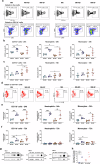Malnutrition exacerbates pathogenesis of Lutzomyia longipalpis sand fly-transmitted Leishmania donovani
- PMID: 40360769
- PMCID: PMC12075822
- DOI: 10.1038/s42003-025-08106-8
Malnutrition exacerbates pathogenesis of Lutzomyia longipalpis sand fly-transmitted Leishmania donovani
Abstract
Visceral leishmaniasis (VL) is transmitted by Leishmania-infected sand fly bites and malnutrition is a known risk factor in human VL. Models using sand fly transmission or malnutrition promote parasite dissemination. By investigating features of L. donovani-Lutzomyia longipalpis transmission to malnourished mice, we show that a comparable IL1-β-driven acute inflammation is maintained in malnourished (MN-SF) and well-nourished (WN-SF) sand fly-infected mice. However, parasite dissemination was more pronounced in MN-SF that had a significantly higher acute (P ≤ 0.001) and chronic (P ≤ 0.0001) splenic parasite burden compared to WN-SF. Compared to WN-SF, MN-SF exhibited chronic clinical symptoms (P ≤ 0.0001), neutrophilia (P ≤ 0.001), lymphocytopenia (P ≤ 0.0001), increased heme oxygenase-1 (P ≤ 0.001) and IL17-A (P ≤ 0.0001) levels, dysregulation of liver enzymes, lymph node barrier dysfunction, and augmented dysbiosis, all associated with enhanced VL severity. Combining vector-transmission and malnutrition provides an improved model to study VL pathogenesis and host defense.
© 2025. This is a U.S. Government work and not under copyright protection in the US; foreign copyright protection may apply.
Conflict of interest statement
Competing interests: The authors declare no competing interests.
Figures





References
-
- World Health Organization. WHO: Leishmaniasis Fact Sheet. https://www.who.int/news-room/fact-sheets/detail/leishmaniasis (2024).
-
- UNICEF. One third of children in the developing world are stunted by malnutrition. (2009).
-
- Badaro, R., Carvalho, E. M., Rocha, H., Queiroz, A. C. & Jones, T. C. Leishmania donovani: an opportunistic microbe associated with progressive disease in three immunocompromised patients. Lancet1, 647–649 (1986). - PubMed
-
- Cerf, B. J. et al. Malnutrition as a risk factor for severe visceral leishmaniasis. J. Infect. Dis.156, 1030–1033 (1987). - PubMed
MeSH terms
Grants and funding
LinkOut - more resources
Full Text Sources
Medical

